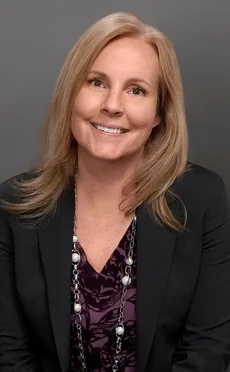Goldman inks modeling, data tie-up with MSCI
The move to cross-sell risk analytics could herald further content deals for the bank’s Marquee platform, says its sales chief.

Goldman Sachs is to partner with risk software vendor MSCI, in a bid to bolster the data and analytics the bank offers its clients—and to reach new ones. MSCI will distribute Goldman’s volatility data to its customers, while the bank’s clients will get access to MSCI’s risk factor models via Goldman’s technology platform for institutional investors, Marquee.
The tie-up underlines Goldman’s growing willingness to collaborate with vendors—a change of approach for the US bank, which has hitherto largely focused on making its proprietary data and software available to clients as apps on Marquee, its self-described ‘digital storefront.’ MSCI will initially distribute Goldman’s equity implied volatility data, but additional asset classes will be added in future, including rates, credit and foreign exchange.
Anne Marie Darling, head of Marquee distribution at Goldman Sachs, predicts that other wholesale financial services companies will take the same path, trying to offer a wider array of services, without necessarily owning the intellectual property.
“We think the institutional space is quickly going to evolve to where the consumer space has already evolved to, and we see that happening quite quickly over the next couple of years. We’re very focused from a Marquee perspective on being the technology provider, but offering lots of different solutions, depending on how clients want to access that, whether it’s our IP or someone else’s IP,” she says.
Marquee is the platform Goldman encourages clients to turn to first to consume its research, proprietary data, risk analytics and execution services. Much of the platform’s functionality has its roots in SecDB (SecuritiesDatabase), the bank’s proprietary risk system, certain features of which the bank began offering clients access to in 2016.
The bank’s army of in-house developers began building apps to distribute through Marquee as far back as 2013. Many early developments were proof-of-concept in nature, and included Strategy Studio, an app designed to help money managers turn fundamental market convictions into quantitative investment strategies, and Simon (Structured Investment Marketplace and Online), an app focused on structured products distributor clients.
We think the institutional space is quickly going to evolve to where the consumer space has already evolved to, and we see that happening quite quickly over the next couple of years
Anne Marie Darling, Goldman Sachs
Other banks have since followed suit by opening up functionality from their own systems, as part of a wider push among dealers to build ancillary revenues by making in-house tech available to clients—recouping some of the billions of dollars invested in technology along the way.
Marquee has seen a raft of changes in its senior leadership since the project’s inception. Until last year, it was overseen by Adam Korn, co-head of engineering for Goldman’s securities arm. He left the bank after a two-decade career in April 2020, according to his LinkedIn profile. In September, Korn joined investment firm Sixth Street Capital, as chief information officer (CIO), reuniting with the firm’s vice-chairman Marty Chavez. At Goldman, Chavez finished his career as the bank’s chief financial officer, but he had previously also been its CIO, and in that role was the driving force behind the build-out of Marquee.
Marquee’s success—the bank says the platform currently has some 80,000 active users a month on average, up from 50,000 a couple of years ago—will ultimately be judged on whether it helps the bank grow its customer base, Goldman’s Darling says, “measured by client engagement, stickiness [and] retention”.

The next phase of the bank’s evolving plans for Marquee will see it roll out functionality to clients from proprietary systems not rooted in risk management, she adds.
“If we’re already doing something for ourselves, can we provide those same capabilities to clients?” says Darling. “We’ve obviously built a lot of the infrastructure based on SecDB—but what can we offer more broadly, so clients don’t have to replicate a lot of that themselves?”
Goldman’s clients will now be able to access MSCI’s risk factor models via an application programming interface (API) and GS Quant—the bank’s open-source Python toolkit designed by its quants to help clients integrate its data feeds into their own trading architecture.
Marquee wants its services to be “API-first”, says Darling—tapping into a preference among clients to route and translate information from execution venues and service providers into a format that makes sense for their own technology environment.
“The differentiation we’re seeing in the industry, at least on the institutional side, is a move to more programmatic access, because firms want to incorporate [our data] with some of their own proprietary IP,” says Darling.
“The first movers have been larger firms, but I would say, as people move and start up their own shops, we’re seeing that trend continue, because everyone is very focused on hiring data scientists or quants to really create alpha or streamline some of their workflows. So I think that will continue to proliferate throughout the industry over the next couple of years.”
MSCI’s risk factor models business was bolstered by the firm’s 2004 buyout of Barra, a portfolio risk management-focused vendor, for $816 million. MSCI Barra models use fundamental and technical factors such as a stock’s volatility and liquidity to build a risk profile of that security, allowing an investor to assess its risk relative to its peer group or the wider market when constructing a portfolio or weighing up an investment decision.
Further reading
Only users who have a paid subscription or are part of a corporate subscription are able to print or copy content.
To access these options, along with all other subscription benefits, please contact info@waterstechnology.com or view our subscription options here: http://subscriptions.waterstechnology.com/subscribe
You are currently unable to print this content. Please contact info@waterstechnology.com to find out more.
You are currently unable to copy this content. Please contact info@waterstechnology.com to find out more.
Copyright Infopro Digital Limited. All rights reserved.
As outlined in our terms and conditions, https://www.infopro-digital.com/terms-and-conditions/subscriptions/ (point 2.4), printing is limited to a single copy.
If you would like to purchase additional rights please email info@waterstechnology.com
Copyright Infopro Digital Limited. All rights reserved.
You may share this content using our article tools. As outlined in our terms and conditions, https://www.infopro-digital.com/terms-and-conditions/subscriptions/ (clause 2.4), an Authorised User may only make one copy of the materials for their own personal use. You must also comply with the restrictions in clause 2.5.
If you would like to purchase additional rights please email info@waterstechnology.com
More on Data Management
New working group to create open framework for managing rising market data costs
Substantive Research is putting together a working group of market data-consuming firms with the aim of crafting quantitative metrics for market data cost avoidance.
Off-channel messaging (and regulators) still a massive headache for banks
Waters Wrap: Anthony wonders why US regulators are waging a war using fines, while European regulators have chosen a less draconian path.
Back to basics: Data management woes continue for the buy side
Data management platform Fencore helps investment managers resolve symptoms of not having a central data layer.
‘Feature, not a bug’: Bloomberg makes the case for Figi
Bloomberg created the Figi identifier, but ceded all its rights to the Object Management Group 10 years ago. Here, Bloomberg’s Richard Robinson and Steve Meizanis write to dispel what they believe to be misconceptions about Figi and the FDTA.
SS&C builds data mesh to unite acquired platforms
The vendor is using GenAI and APIs as part of the ongoing project.
Aussie asset managers struggle to meet ‘bank-like’ collateral, margin obligations
New margin and collateral requirements imposed by UMR and its regulator, Apra, are forcing buy-side firms to find tools to help.
Where have all the exchange platform providers gone?
The IMD Wrap: Running an exchange is a profitable business. The margins on market data sales alone can be staggering. And since every exchange needs a reliable and efficient exchange technology stack, Max asks why more vendors aren’t diving into this space.
Reading the bones: Citi, BNY, Morgan Stanley invest in AI, alt data, & private markets
Investment arms at large US banks are taken with emerging technologies such as generative AI, alternative and unstructured data, and private markets as they look to partner with, acquire, and invest in leading startups.







